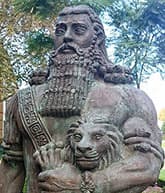Author of The Epic of Gilgamesh
Critique
Born
Unknown
Died
Unknown
Places lived
Sumer, Mesopotamia; other unknown
Publication
Poetry
Genres
Literary, epic, mythology
Writing language
Akkadian
Literature
• The Epic of Gilgamesh (c.2100-1200 BCE)
Poems
• The Epic of Gilgamesh (c.2100-1200 BCE)
We who have seen the deep
No one person wrote The Epic of Gilgamesh. Not even any one people can be said to have written it collectively. But generations of several civilizations created the story, added to it, wrote it down, translated it, and edited the collection of tales that came to be known as Gilgamesh.
And after all that, we lost it. Forgot it all. Almost for good.
Only in the nineteenth century, two millennia after the last ancient copies were distributed and nearly five millennia after the reign of the semi-mythical king who inspired the epic, was Gilgamesh rediscovered by the modern world.
In 1853 archaeologists at the site of the ancient city of Nineveh in Mesopotamia (today largely the area known as Iraq) were looking for sculptures for the British Museum, when they dug up an ancient library containing thousands of broken clay tablets with cuneiform writing .
Even then, those shards with wedge-shaped markings sat nearly two decades in the British Museum before some of the pieces were translated from the Assyrian by a self-taught cuneiform expert.
George Smith's announcement in 1872 of his rendering of an account of a great flood caused great excitement as it seemed to verify the biblical story of the Flood and Noah's Ark. His translation was published in 1876 as the Chaldean Account of the Deluge, Chaldean referring to the Babylonian period of the sixth century BCE from which the tablets dated.
However, over the years as more clay tablets were found and translated to flesh out the story, it became apparent that, as Smith had suspected, the story was a copy of one from much earlier. In fact, this flood story predated the biblical myth. Moreover, the flood tale was only part of a story told within a much larger story, an epic about the exploits of a certain King Gilgamesh.
As more pieces of tablets have been uncovered in the Middle East and translated from a variety of ancient languages, the incomplete story has been filled in and reconfigured—a process still continuing. The Epic of Gilgamesh, as it's come to be known, is actually just one central story in a sea of ancient poems and tales swirling about the real and imagined hero. Some of the threads have been woven into the the accepted epic, while others remain outside the canon and scholars debate about the possible inclusion of other Gilgamesh myths.
Birth of a divinity
Here's a rough historical rundown on how it's thought to have come together (bearing in mind scholars disagree about some of the dating).
2800–2500 BCE: Gilgamesh, also known as Bilgames, reigns for 126 years as king of the city-state Uruk, according to the quasi-historical Sumerian list of kings.
2500–2300 BCE: Gilgamesh becomes a cult figure, a divinity, among Sumerians.
2300 BCE: The first poems about Gilgamesh are thought to be passed around orally in Mesopotamia, dominated by the city-states of the Sumer people.
2100–2000 BCE: The first written (chiselled actually) poem about Gilgamesh is produced in Sumerian, the world's oldest known writing.
1800–1700 BCE: Copies of poems about Gilgamesh are flourishing in Sumerian and Akkadian, the language of the early Babylonian successors to the Sumerians. They include the Old Babylonian version of the Gilgamesh epic, known as Surpassing All Other Kings.
1500–1300 BCE: Middle Babylonian versions of the Gilgamesh epic appear throughout the Middle East.
1200–1000 BCE: Babylonian priest Sin-liqe-unninni edits the Babylonian epic into what's come to be known as the Standard Version of The Epic of Gilgamesh, , also known as He Who Saw the Deep. He created eleven tablets (or chapters, as it is organized now), plus a twelfth tablet based on the earlier Sumerian poem "Gilgamesh, Enkidu, and the Netherworld".
1000–130 BCE: Copies of the Standard Version epic appear throughout the Middle East in various languages.
After this, no more copies appear to have been created until the nineteenth century CE.
In a way, however, the Gilgamesh epic is still being written. Since its rediscovery, each generation of researchers has produced not only new translations incorporating the latest fragmentary findings, but authors have also produced creative new interpretations in a variety of forms and styles from ancient to contemporary.
The author of our oldest extant literature, it seems, is human civilization as a whole.
— Eric
Critique


